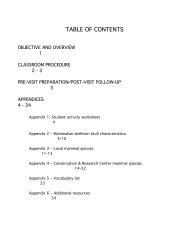facilities renewal master plan - National Zoo - Smithsonian Institution
facilities renewal master plan - National Zoo - Smithsonian Institution
facilities renewal master plan - National Zoo - Smithsonian Institution
You also want an ePaper? Increase the reach of your titles
YUMPU automatically turns print PDFs into web optimized ePapers that Google loves.
FACILITIES MASTER PLAN ENVIRONMENTAL ASSESSMENT<br />
The <strong>National</strong> <strong>Zoo</strong> is proposing an incentive for employees to use public transportation<br />
that could result in reduced vehicle trips by employees to the <strong>Zoo</strong> and therefore, reduce<br />
emissions.<br />
Overall, Alternatives A, B, and C would have minor short-term adverse impacts from<br />
construction activities associated with exhibit and <strong>facilities</strong> <strong>renewal</strong>. Implementation of<br />
Alternatives A, B, or C would not be expected to generate an increase in vehicular traffic,<br />
change land use, or affect employment patterns at the <strong>National</strong> <strong>Zoo</strong>; therefore, no longterm<br />
impact on air quality would occur.<br />
Mitigation for the Preferred Alternative<br />
Best management practices will be utilized during construction of individual projects to<br />
avoid and/or minimize the release of airborne pollutants. Such practices could include,<br />
but would not be limited to, the use of water to control airborne dust in active grading<br />
areas and material stockpiles, and the use of temporary vegetative cover and/or barriers<br />
on inactive areas. To the extent possible, commercial power will be used over portable<br />
generators during construction of projects to reduce temporary impacts to air quality.<br />
More detailed air quality mitigation will be prepared during the conceptual design phase<br />
of individual projects.<br />
A.6 Noise<br />
The extent to which individuals are affected by noise is controlled by several factors,<br />
including:<br />
The duration and frequency of sound;<br />
The distance between the sound source and the receptor;<br />
The intervening natural or man-made barriers or structures; and<br />
The ambient environment.<br />
The “A-weighted” decibel (dBA) is a unit of measure used to express the relative<br />
loudness of sounds in the air as perceived by the human ear. The dBA scale deemphasizes<br />
the very low and the very high frequencies and emphasizes the middle<br />
frequencies, thereby closely approximating the frequency response of the human ear.<br />
Common noise sources and their sound levels are described in the table below.<br />
SMITHSONIAN INSTITUTION – NATIONAL ZOOLOGICAL PARK 58 | P a g e

















